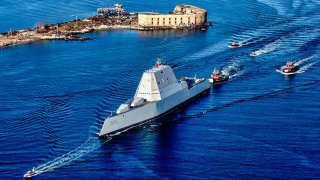The Incredible Shrinking U.S. Navy Is a Nightmare (Smallest Since 1917)
The U.S. Navy faces significant challenges as it seeks to expand its fleet amidst a backdrop of diminishing shipbuilding capacity and recruitment struggles. The Navy's fleet size, the smallest since World War I, combined with a shortfall in recruiting goals, raises concerns about its ability to maintain operational standards and safety.
Summary: The U.S. Navy faces significant challenges as it seeks to expand its fleet amidst a backdrop of diminishing shipbuilding capacity and recruitment struggles. The Navy's fleet size, the smallest since World War I, combined with a shortfall in recruiting goals, raises concerns about its ability to maintain operational standards and safety.
-The Government Accountability Office has highlighted that crewing shortfalls have contributed to accidents, with ships operating with only 84% of the required sailors. In response, Secretary of the Navy Carlos Del Toro has issued a National Call to Maritime Service, aiming to bolster recruitment by emphasizing the honor and opportunities provided by service in the Navy and Marine Corps.
-As the Navy endeavors to grow and modernize, the success of this recruitment drive is crucial to its future readiness and capabilities.
U.S. Navy Struggles with Recruitment and Fleet Expansion Amidst Historical Challenges
In 2015, during the Republican presidential primaries a point was repeatedly made that the United States Navy had just 272 ships in its "deployable battle force" – the smallest since 1917, when the U.S. entered the First World War. The situation hasn't gotten much better in nearly a decade, and the sea service will continue to downsize as part of long-term goals to expand.
Ominously, the U.S. Navy is facing several issues – including the fact that even as the U.S. can afford a larger fleet, we really can't build it. Washington currently lacks the shipyards to build and maintain a sizeable U.S. Navy fleet, and the problem is also likely to get worse before it gets better.
The other issue is that in recent years, the U.S. Navy has struggled to meet its recruiting goals. The U.S. Navy had a 2023 enlistment goal of 37,700, yet, it brought in just 31,834. For 2024, the U.S. Navy had raised the bar to 40,600 – as it is set to reach a total strength of 337,800.
That problem has gotten so dire that in January, the sea service announced it would enlist individuals who didn't graduate from high school or even obtain a GED (General Educational Development) certificate.
Not Enough Sailors for U.S. Navy
This month, the Government Accountability Office (GAO) issued a warning that the U.S. Navy has been forced to assign fewer crewmembers to ships than are required to operate them safely, and such crewing shortfalls have contributed to accidents.
The watchdog group found that U.S. Navy vessels are heading out to sea with just 84% of the enlisted sailors that should be deployed to the vessels. Greater use of automation, which is employed on the latest U.S. Navy vessels, including the Gerald R. Ford -class aircraft carriers is helping, but it isn't enough.
Last week, GAO Defense Capabilities and Management Team Director Diana Maurer said during testimony before the Senate Armed Services Committee, "The Navy does not have enough sailors for the current fleet, much less the fleet of the future.
A National Call to Maritime Service
Simply put, the U.S. Navy needs more sailors – lots of them! Yet, instead of further lowering the standards for recruits, the U.S. Navy's top civilian official issued a National Call to Maritime Service during the kick-off of the inaugural Fleet Week Miami on Monday.
"Service in the Navy and Marine Corps is more than just a job. It represents a chance to serve something bigger than yourself," said Secretary of the Navy Carols Del Toro. "We recognize the desire of Americans from all walks of life to use their talents to better our great Nation, to be part of a legacy of courage and honor that stretches back to the very founding of our nationand beyond."
As the 78th secretary of the sea service, Del Toro leads a department that consists of nearly one million sailors, marines, and civilians who provide direct and indirect support to the economic and national security of the United States.
"No matter how you serve, you'll be part of a team working together toward a shared goal," added Del Toro, a Cuban-born immigrant who came to America when he was just 10 months old, and who graduated from the United States Naval Academy in Annapolis, Maryland, and then served on active duty in the Navy for 22 years.
"You'll learn invaluable skills and gain leadership experience," Del Toro explained. "Collectively, as a Sailor, Marine, or civilian, you will take part in tackling the world's toughest challenges while preserving America's advantage across several cutting-edge technologies."
Whether Del Toro's call is answered remains the question, but the point is clear, if the U.S. Navy is going to expand, it is going to need a lot more sailors
Author Experience and Expertise: Peter Suciu
Peter Suciu is a Michigan-based writer. He has contributed to more than four dozen magazines, newspapers, and websites with over 3,200 published pieces over a twenty-year career in journalism. He regularly writes about military hardware, firearms history, cybersecurity, politics, and international affairs. Peter is also a Contributing Writer for Forbes and Clearance Jobs. You can follow him on Twitter: @PeterSuciu. You can email the author: [email protected].


